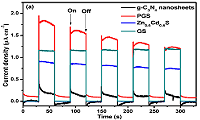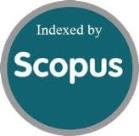0D/2D P-doped ZnxCd1-xS/g-C3N4 Heterojunctions towards Highly Efficient Photocatalytic Hydrogen Evolution
Keywords:
P-doped ZnxCd1-xS/g-C3N4, heterojuctions, photocatalysis, hydrogen evolutionAbstract
Solar-driven water splitting over semiconductor photocatalysts is a promising approach for converting solar energy into renewable and storable chemical energy. CdS, an efficient photocatalyst for hydrogen evolution, suffers from high recombination of photogenerated electron-hole pairs and high photocorrosion in aqueous media, which limit its practical applications. Doping and the formation of heterojunctions are two efficient methods to improve the photocatalytic activities of photocatalysts. Herein, we rationally designed and fabricated P-doped 0D/2D ZnxCd1-xS/g-C3N4 nanocomposites by in-situ immobilizing ZnxCd1-xS onto the surface of g-C3N4 nanosheets in a hydrothermal environment, followed by a phosphorization process. The as-prepared P-doped ZnxCd1-xS/g-C3N4 nanocomposites were systematically characterized by analyzing the phase structure, chemical components, electronic and optical properties and separation of charge carriers. More importantly, these P-doped ZnxCd1-xS/g-C3N4 heterostructures have been proven to be highly efficient visible light responsive photocatalysts for hydrogen evolution, and meanwhile exhibit excellent photo-stability during recycling runs. The sufficient evidence exhibit that the significantly improved photocatalytic performance is mainly attributed to the prolonged lifetime of charge carriers and the improved separation efficiency of photogenerated electron-hole pairs.

Published
How to Cite
Issue
Section
License
Submission of a manuscript implies: that the work described has not been published before that it is not under consideration for publication elsewhere; that if and when the manuscript is accepted for publication. Authors can retain copyright of their article with no restrictions. Also, author can post the final, peer-reviewed manuscript version (postprint) to any repository or website.

Since Oct. 01, 2015, PETI will publish new articles with Creative Commons Attribution Non-Commercial License, under The Creative Commons Attribution Non-Commercial 4.0 International (CC BY-NC 4.0) License.
The Creative Commons Attribution Non-Commercial (CC-BY-NC) License permits use, distribution and reproduction in any medium, provided the original work is properly cited and is not used for commercial purposes



